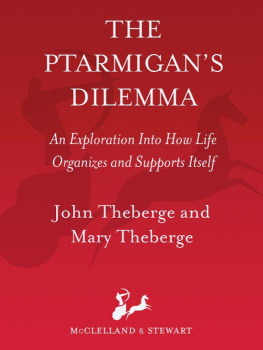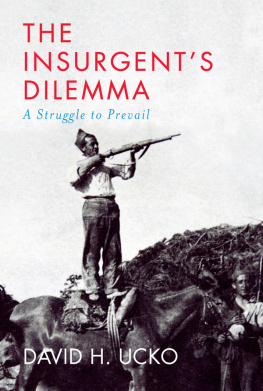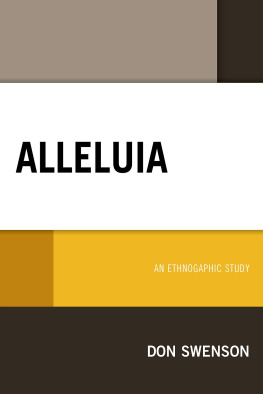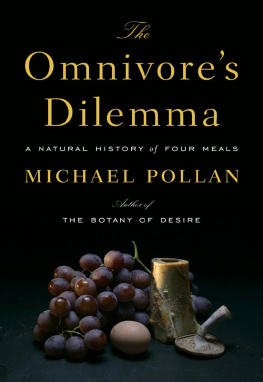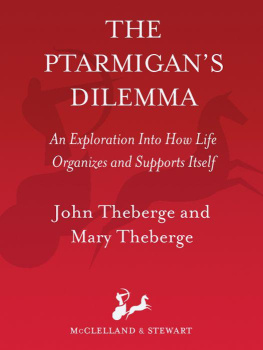Theberge - The Ptarmigan’s Dilemma: An Exploration into How Life Organizes and Supports Itself
Here you can read online Theberge - The Ptarmigan’s Dilemma: An Exploration into How Life Organizes and Supports Itself full text of the book (entire story) in english for free. Download pdf and epub, get meaning, cover and reviews about this ebook. publisher: McClelland & Stewart, genre: Detective and thriller. Description of the work, (preface) as well as reviews are available. Best literature library LitArk.com created for fans of good reading and offers a wide selection of genres:
Romance novel
Science fiction
Adventure
Detective
Science
History
Home and family
Prose
Art
Politics
Computer
Non-fiction
Religion
Business
Children
Humor
Choose a favorite category and find really read worthwhile books. Enjoy immersion in the world of imagination, feel the emotions of the characters or learn something new for yourself, make an fascinating discovery.
The Ptarmigan’s Dilemma: An Exploration into How Life Organizes and Supports Itself: summary, description and annotation
We offer to read an annotation, description, summary or preface (depends on what the author of the book "The Ptarmigan’s Dilemma: An Exploration into How Life Organizes and Supports Itself" wrote himself). If you haven't found the necessary information about the book — write in the comments, we will try to find it.
Theberge: author's other books
Who wrote The Ptarmigan’s Dilemma: An Exploration into How Life Organizes and Supports Itself? Find out the surname, the name of the author of the book and a list of all author's works by series.
The Ptarmigan’s Dilemma: An Exploration into How Life Organizes and Supports Itself — read online for free the complete book (whole text) full work
Below is the text of the book, divided by pages. System saving the place of the last page read, allows you to conveniently read the book "The Ptarmigan’s Dilemma: An Exploration into How Life Organizes and Supports Itself" online for free, without having to search again every time where you left off. Put a bookmark, and you can go to the page where you finished reading at any time.
Font size:
Interval:
Bookmark:

BY THE SAME AUTHORS
Wolves and Wilderness
Kluane: Pinnacle of the Yukon
Legacy: A Natural History of Ontario
Wolf Country: Eleven Years Tracking the Algonquin Wolves

For Jenny and Michelle, who have travelled with us on many
of these journeys of exploration
4
12
15

PROLOGUE
A TWIG IN AN EDDY
The trail winds steeply upslope from valley timber to sunlit alpine meadow. On all sides, the mountains march off into the distance. A marmot whistles, and a mule deer bounds away. There is a wholeness to ecosystems, an order, an interlocking of species, an unaccountable richness, an intricate design without planner, engineer, or architect.
But there is an operating manual.
IN THE SOUTHWEST Y UKON stands Amphitheatre Mountain, a low mountain in comparison with the looming giants to the west. Early in our careers together as wildlife biologists and naturalists, we came to know this mountain well. We often camped there, in summer sunshine and fall snows, because it provided a tundra vantage point to observe woodland caribou whose ecology we were trying to understand. The caribou moved in and out of nearby Kluane National Park, and in those years their numbers had dwindled.
Amphitheatre Mountain features a flat, plateau-like top that can be reached by a stiff climb up its western slope. White Dalls sheep graze its lower flanks, keeping its eastern crags in view as escape terrain, and peregrine falcons use those crags for eyries.
But most significant to our story, the mountain features the remains of a stone forest. One day we watched a golden eagle swoop down and land on a rock protruding from the ground. A rock? It looked more like a stump, but this was treeless tundra. We investigated and found it was a stump petrified. Only then did we realize that many of the rock outcrops around us were actually petrified wood, including the one wed used as our favourite perch. Some of the wood had been transformed into coal; some was an off-white that clearly showed ancient tree rings stained brown.
The stump had been a metasequoia, remnant of a warm, wet forest that grew in the Yukon some 35 million years ago when the land was an inland plain, before the coastal ranges rose. Planet Earth was once believed to be completely stable, but now we know that, on its tumultuous journey through time, its amoeboid surface contorted as mountains rose and eroded away, sea floors appeared and vanished, continents split and drifted apart, rivers were born, carved canyons, and disappeared. And through all its transformations has streamed a panoply of life.
Those fossils, and others we have admired in situ pumice rocks from Washington State etched with 48-million-year-old maple leaves; pieces of Wyoming sandstone with 50-million-year-old fish imbedded in them; chunks of dark red 150-million-year-old petrified wood from Arizona; a coprolite (petrified dung) from the intestines of some unknown coyote-sized early mammal or dinosaur all whisper about a time before humans were around to appreciate, or wonder, or piece together how the self-organization and persistence of life ever came to be. How has life kaleidoscoped through the ages to arrive at what we have today? How, with no endangered species act, no conservation lobby to express outrage at environmental calamities, no environmental policies, did living things struggle through adversity and endow us today with a rich biological inheritance unparalleled in the history of life without planner, engineer, or architect?
This book is a journey of discovery of the ways life adapts, persists, and is able to organize itself at all the different levels of existence, from genes to whole ecosystems, as seen through the eyes and experiences of wildlife ecologists. At each of the levels of lifes organization, novel mechanisms have accompanied new opportunities as life, behaving like a twig in an eddy, has seemingly poked and probed until it found a way to continue its journey. What are the mechanisms? How do they work? And why?
Any good journey leads somewhere, and we found ourselves arriving at several destinations. One is the satisfaction of a holistic view of life, in which some of its mystery has been supplanted by an appreciation of how things work. Another destination is a platform for viewing, participating in, and helping to resolve the plethora of environmental issues that face the world today. The problems are severe, from disappearing species and the consequent impoverishment of life to the instability caused by climate change, pollution by toxic chemicals, and the one force that increasingly dictates a different future for life in all forms us. Other books have delved into the details of particular environmental problems and their possible solutions. Our book attempts to answer the more fundamental, underlying questions and provide a science-based view and comprehension of life. The final destination of our journey is a perspective, a prognosis, for the future of life on Earth.
Our early married life was a time of heightened environmental concern driven by the shocking scenarios described by such writers as Rachel Carson in Silent Spring (1962) and Paul Ehrlich in The Population Bomb (1968). Everyone wanted to be an ecologist in the 1960s. But there was a hole in the environmentalism of the day, an unsettling lack of understanding about the ways life is organized, an absence of any unifying or central concept of how life supports itself. We were like surgeons operating on a heart attack victim without understanding the basic circulatory system. While money poured in for environmental impact assessments, little was made available for basic research to plug that information hole. We, like some of our colleagues, had some disturbing experiences with impact assessments, naively and inadvertently covering for developers who really didnt give a damn about the environment.
But the impact assessments we engaged in, along with the pure research dollars we managed to scrounge, allowed us to experience some superb wild country. So our lives have been sprinkled with experiences that have repeatedly raised the same basic questions: How is lifes marvellous self-organization accomplished? When and why might it fail? What of the future?
Today, scientific knowledge in many fields has accumulated to the point that these questions can be addressed more effectively than was possible in the early days of environmentalism of the 1960s. These are exciting times. Unparalleled advances are changing how we understand the living world. New discoveries are uncovering the ways living things are hooked together (ecology), and the processes that got them there (evolution). Firing them has been an array of technological advances, from computers that allow us to squeeze added meaning out of data, and telemetry that reveals the precise movements of animals, to satellites that map ecosystems from afar.
These are also crucial times. Never before has a population of any species tried to rejig so much of the world to its own ends. The result is unprecedented pressure on the global systems that support life. We need to detect the land mines.
Yet, these are deeply satisfying times, too, when an appreciation of the beauty and mystery of the natural world is increasingly grounded in science. The forefronts of science keep coming at us like incoming waves. The natural world operates with both tricks and surprises, force and fury. It is both astonishingly complex and simple.
Font size:
Interval:
Bookmark:
Similar books «The Ptarmigan’s Dilemma: An Exploration into How Life Organizes and Supports Itself»
Look at similar books to The Ptarmigan’s Dilemma: An Exploration into How Life Organizes and Supports Itself. We have selected literature similar in name and meaning in the hope of providing readers with more options to find new, interesting, not yet read works.
Discussion, reviews of the book The Ptarmigan’s Dilemma: An Exploration into How Life Organizes and Supports Itself and just readers' own opinions. Leave your comments, write what you think about the work, its meaning or the main characters. Specify what exactly you liked and what you didn't like, and why you think so.

